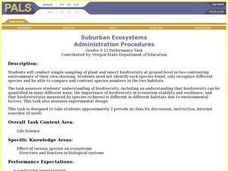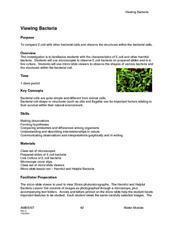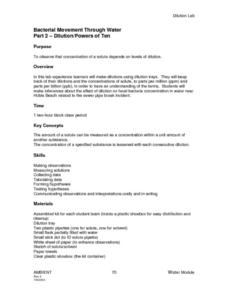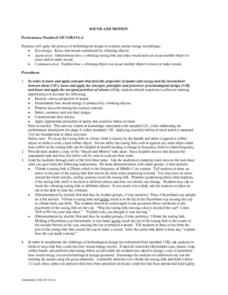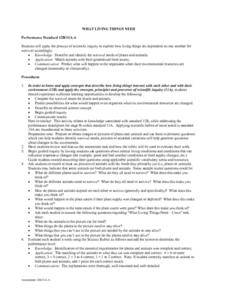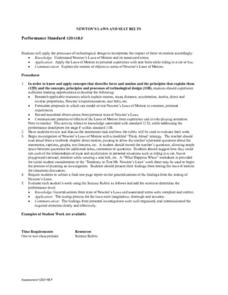Curated OER
How Effective is Perspiration at Cooling?
High schoolers collect data on the cooling of water in two different test tubes, one that is wrapped in wet newspaper and one in dry newspaper. They then relate this cooling effect to the body's perspiration.
Curated OER
A Cut Above the Rest Administration Procedures
Learners analyze how the Law of Conservation of Energy applies to the design and use of scissors. Working in groups, they determine the output work for a standard pair of scissors.
Curated OER
Deliver
High schoolers measure the mass, volume, length and area of various objects. They are assigned a letter. The task is assesses students' abilities to make simple observations and measurements.
Curated OER
Instruments and Measurement
High schoolers circulate through stations to determine the proper instrument to make a certain type of measurement. They must make measurements of mass, volume, length, area, electrical current, temperature and force.
Curated OER
Are Enzymes Specific for Their Substrates?
High schoolers discover enzyme to substrate specificity. The experiment uses samples of glucose and lactose in combination with the enzyme lactase. Students observe the reaction between the lactose and the lactase; the lack of a...
Curated OER
Suburban Ecosystems
Learners conduct simple sampling of plant and insect biodiversity at ground level in two contrasting environments of their own choosing. They recognize and record different species then compare and contrast species numbers in the two...
Curated OER
Coat Caper
Students examine pollen and fibers taken from a garment. They analyze pollen from new hybrids and compare it to the samples from the garment then make individual conclusions concerning the specific historical authenticity of the garment.
Curated OER
Micro- To Macro- Environmental Air Quality Risk Survey
Students research the importance of air quality. In groups, students explore factors leading to poor air quality and methods of minimizing air pollution. Given a diagram of concentric circles, students survey their personal air quality...
Curated OER
Photosynthesis: Intake of Carbon Dioxide - Production of Oxygen
Students, after a long-term observation of photosynthesis with aquatic plants, assess the benefits of photosynthesis towards all living organisms. They explain in their own words the two cycles within photosynthesis. Guided discussion...
Curated OER
Indoor Air Pollutant Sensing LAB Lead-In: A Canary in a Coal Mine?
Students investigate the causes of carbon monoxide in mines and other common sources of CO. Pupils read the worksheet "Canary in a Coal Mine" before beginning this investigation. They discuss ethical issues regarding treatment of miners...
Curated OER
Foodborne Illness Educational Materials
High schoolers work in teams to research and create educational material succinctly summarizing known salient fact, including prevention, of a particular foodborne illness. Pupils educational materials are presented in both oral and...
Curated OER
Lead Particulate Simulation
Young scholars visualize contaminate particles as they are released into the air and observe their ultimate settling. They watch a demonstration about lead particles and discuss the various ways that lead particles can be introduced into...
Curated OER
Lead Detection
Pupils explore one method for the detection of lead in soil. The detection of the presence of lead in soil can be determined sensitively using inexpensive swabs. Pupils collect several spoonfuls of soil from various parts of their yards...
Curated OER
Viewing Bateria
Students use microscopes to observe E. coli bacateria on prepared slides and in a live culture. They use micro-slide viewers to observe the shapes of various bacteria and the structures within the bacterial cell. Students make an...
Curated OER
Bacterial Movement Through Water Part 2- Dilution/Powers of Ten
High schoolers make dilutions using dulution trays. They keep track of their dilutions and the concentrations of solute, to parts per million (ppm) and parts per billion (ppb), in order to have an comprehension of the terms. Students...
Curated OER
Human Body Parts
Students create body cutouts of themselves and label specific internal and external organs/parts that are covered in class in this exciting lesson on Human Anatomy. Digital cameras and pictures of various internal organs are required.
Curated OER
Scientific Tools
Students list different uses for common scientific instruments. They identify appropriate instruments to measure length, temperature, and mass. Pupils are given a copy of the "Science Tools" task sheet, students place the correct number...
Curated OER
Major Functions
Seventh graders investigate the basic characteristics and needs of living things. They identify the major parts of plants and animals by making lists. Students focus upon one living thing and speculate how if one part is changed how it...
Curated OER
Sound And Motion
Young scholars investigate the concept of sound and vibration. They use a tuning fork to make an observation. Students then propose the ideas of different experimental designs to test the concept. The ideas are constructed and then tested.
Curated OER
What Living Things Need
Students apply the process of scientific inquiry to explore how living things are dependent on one another for survival. They match animals with their generalized food source. Students predict what happens to the organisms when their...
Curated OER
Newton's Laws and Seat Belts
Students study Newton's Laws of Motion. They review an assessment task and rubric and discuss Newton's Laws of Motion. They discuss how to test the relationships of mass and acceleration in personal situations. They write a one-page...
Curated OER
What Do Parts Do?
Middle schoolers review the components of the scientific inquiry method. In groups, they identify and describe the components and functions of all of the parts of a plant. Using a diagram, they label the parts of the plant chosen and...
Curated OER
Apply Scientific Inquiry and Scientific Habits of Mind
Students review the components of the scientific inquiry method. In groups, they apply this method to various experiments they are given to complete. They also use the correct scientific habits of mind when researching different concepts.
Curated OER
Magnetic Force
Students are introduced to the attraction and repulsion of magnetic forces. In groups, they observe how the forces react with different materials and record their data. They develop their own conclusions about the poles of magnets and...







